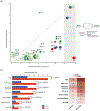The long tail of oncogenic drivers in prostate cancer
- PMID: 29610475
- PMCID: PMC6107367
- DOI: 10.1038/s41588-018-0078-z
The long tail of oncogenic drivers in prostate cancer
Erratum in
-
Publisher Correction: The long tail of oncogenic drivers in prostate cancer.Nat Genet. 2019 Jul;51(7):1194. doi: 10.1038/s41588-019-0451-6. Nat Genet. 2019. PMID: 31152158
Abstract
Comprehensive genomic characterization of prostate cancer has identified recurrent alterations in genes involved in androgen signaling, DNA repair, and PI3K signaling, among others. However, larger and uniform genomic analysis may identify additional recurrently mutated genes at lower frequencies. Here we aggregate and uniformly analyze exome sequencing data from 1,013 prostate cancers. We identify and validate a new class of E26 transformation-specific (ETS)-fusion-negative tumors defined by mutations in epigenetic regulators, as well as alterations in pathways not previously implicated in prostate cancer, such as the spliceosome pathway. We find that the incidence of significantly mutated genes (SMGs) follows a long-tail distribution, with many genes mutated in less than 3% of cases. We identify a total of 97 SMGs, including 70 not previously implicated in prostate cancer, such as the ubiquitin ligase CUL3 and the transcription factor SPEN. Finally, comparing primary and metastatic prostate cancer identifies a set of genomic markers that may inform risk stratification.
Conflict of interest statement
COMPETING FINANCIAL INTEREST
Dr. Van Allen is a consultant for Tango Therapeutics and Genome Medical.
Figures




References
-
- Tomlins SA et al. Recurrent fusion of TMPRSS2 and ETS transcription factor genes in prostate cancer. Science 310, 644–648 (2005). - PubMed
Publication types
MeSH terms
Substances
Grants and funding
LinkOut - more resources
Full Text Sources
Other Literature Sources
Medical
Molecular Biology Databases

